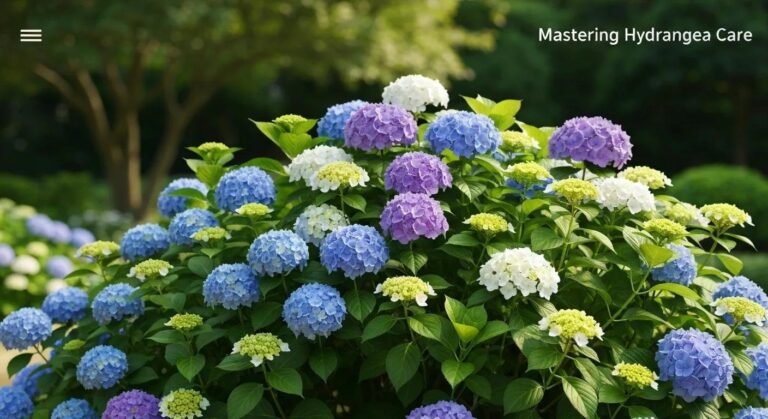
Since moving to Colorado almost a year ago, my gardening journey has been full of trial, error, and a few delightful surprises. I’ve been testing which plants can handle this unique climate, and clematis quickly became one of them. Along the way, I’ve learned a lot about how to grow clematis. In this post, I’m sharing what works so you can enjoy these stunning blooms in your own garden too.
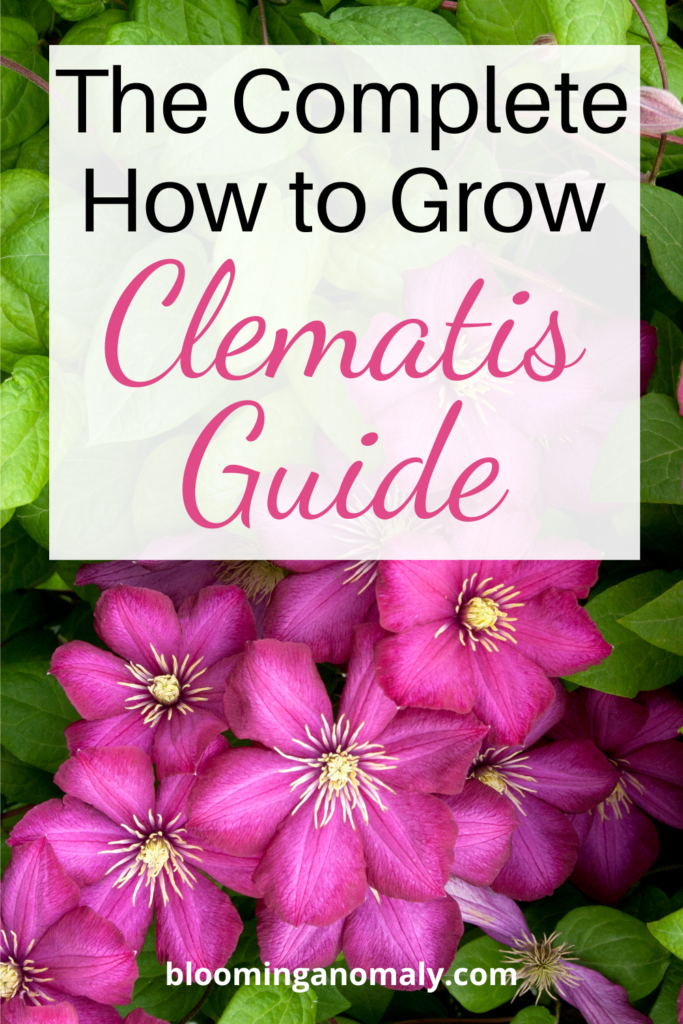
Where to Plant Clematis
Clematis plants grow best in USDA hardiness zones 4–9, making them suitable for many climates. While most clematis are known as climbing vines, there are also lovely shrub varieties for gardeners who prefer a more compact option.
Clematis Care Tips
Here are a few simple tips on how to grow clematis flowers so you can keep them healthy and blooming beautifully all season long.
Light Requirements
Clematis blooms require full sun, although some varieties can grow in partial shade. Make sure your clematis gets at least six hours of sunlight. Keep an eye out for how your plants react to full or part sun. When growing clematis in a pot, try moving it from time to time so it can soak up enough sunshine as the seasons change.
In hotter climates, clematis vines benefit from morning sun and afternoon shade to prevent blooms from fading. If you notice wilting or scorched leaves, try adding a shade-loving groundcover, like hosta or sweet woodruff, around the base to protect the roots. This simple trick mimics their natural woodland habitat and keeps them thriving.
Soil and Water Requirements
Clematis roots enjoy well-drained soil that stays moist. Some clematis varieties can handle dry soil. Water your clematis when the soil surface is dry. You can purchase neutral soil, which clematis enjoy. Water your plants when the top inch layer of the soil is dry.
Fertilizer Needs
Regularly fertilize your clematis during the growing season. Use low nitrogen fertilizer (5-10-10) with new blooms and balanced (10-10-10) fertilizer throughout the growing season.
When and How to Grow Clematis
The best time to plant clematis is in spring or early fall, when the soil is warm but not hot. Start with a healthy nursery plant that has several strong stems.
Dig a hole about twice as wide and deep as the root ball, and mix compost or aged manure into the soil for extra nutrients. Plant the crown of the clematis 2–3 inches below the soil line to protect it from clematis wilt and encourage new shoots.
Water deeply after planting and add a layer of organic mulch to keep the roots cool. Clematis love moisture but dislike soggy feet, so good drainage is essential. Add a trellis or support as you plant so the vine can start climbing right away.

Pruning Clematis
Clematis plants fall into three different pruning groups, each with its own timing and technique. You’ll find more details about each one below.
Group 1
Group 1 consists of new plants that grow on old wood. You want to prune these plants right after they bloom for best results. Only cut off dead wood if you can to avoid removing a new clematis.
Group 2
Group 2 includes old and new growth. Blooms from these plants will grow during the spring and fall. Prune right after blooms in the spring to encourage new large-flowered hybrids to grow.
Group 3
Group 3 are for plants that need to be pruned on new wood. Make sure to prune these plants every spring for vigorous vines to enjoy each year.
How to Propagate Clematis
Propagating these perennial plants can be done with seeds or cuttings. Keep the seeds moist and make sure to have plenty of patience, since new vining clematis can take months to appear. A cutting with a leaf bud is also a good alternative to propagating a young plant to enjoy in the near future.
Types and Varieties of Clematis
There are plenty of different varieties and a variety of colors to choose from to suit your garden design. Here are some common varieties that you can add to a small garden.
Nelly Moser
Nelly Moser grow beautiful blooms in light shades of pink. Enjoy these flowers from late spring until late summer or fall.
Sweet Autumn Clematis
Sweet Autumn Clematis produce white flowers on a vine. Cover a wall or a piece of garden decor to make this plant stand out.
Clematis Montana
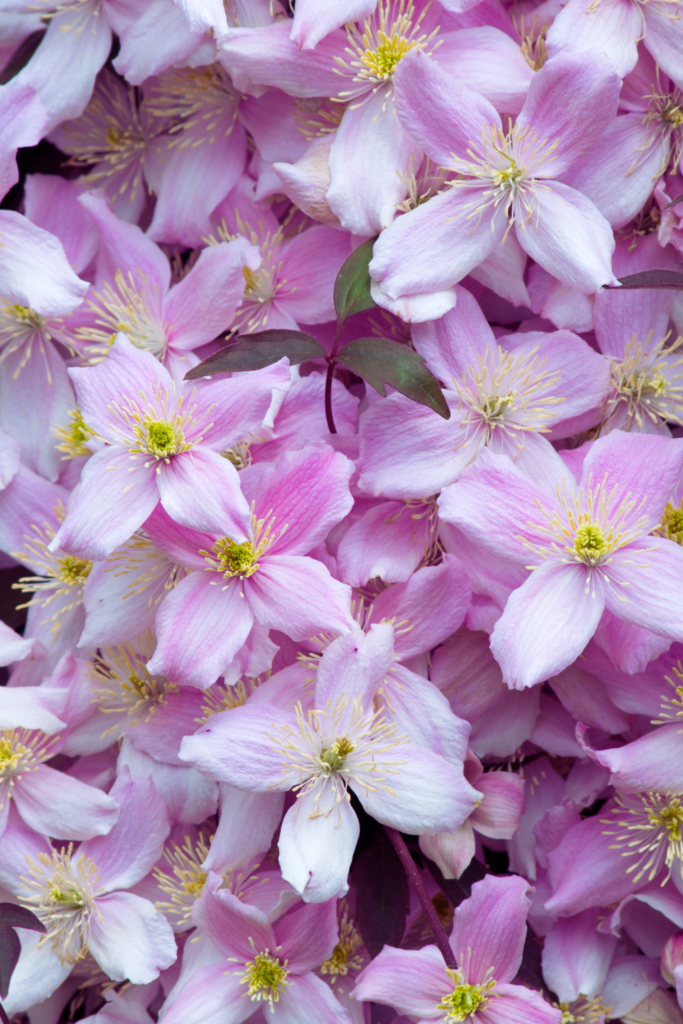
This type of clematis is native to the Himalayas and Asia. This flowering plant produces light pink and white flowers.
C. Armandii
C. Armandii is an evergreen variety with glossy leaves and fragrant white flowers (great for warmer climates).
Duchess of Albany
Also known as C. Viticella, this clematis species blooms dark pink flowers that can make a colorful statement in any garden. The flowers typically bloom from July to September.
Jackmanii
Jackmanii (c. alpoina) is classic deep-purple blooms that add dramatic color.
C. Macropetala
Clematis macropetala blooms in early spring with delicate, bell-shaped flowers that are often double or semi-double. This variety adds soft texture and early-season charm, and its fluffy seed heads continue to decorate the plant after flowering.
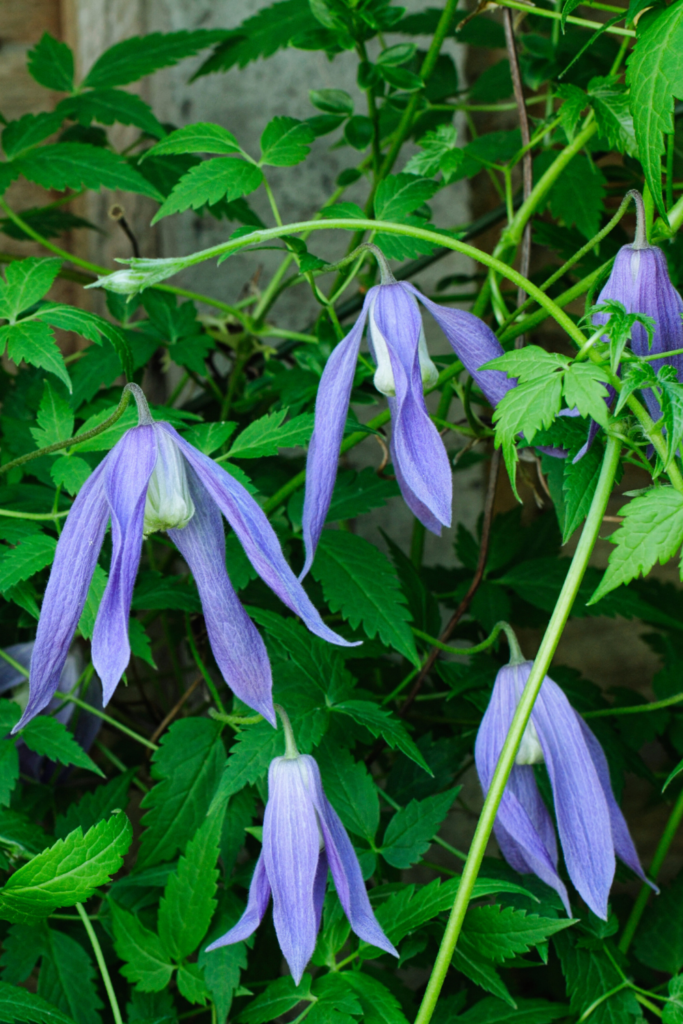
Common Problems and Solutions
When learning how to grow clematis, it helps to know what can go wrong. Below are some common clematis problems and easy ways to solve them.
Clematis Wilt
Clematis wilt is a fungal disease that can negatively affect clematis with larger blooms. One sign of clematis wilt is leaves and stems that wilt and turn black. Cut back the diseased part and mulch around the base of the plant to avoid stressing the root system.
Powdery Mildew
Powdery mildew is another fungal disease that can damage your flowering vines. Powdery mildew happens when the plant does not get enough water. White or gray powdery patches will appear on the leaves and stems. Prune plants to get rid of the mildew. Spraying the plants with a fungicide can also help to remove powdery mildew.
Creating Your Clematis Paradise
Planning to design a garden to include clematis is a great way to incorporate these plants in your outdoor space.
Clematis look stunning climbing over trellises, mailboxes, fences, or even mixed with roses. Pair them with other perennials for layered texture and color throughout the seasons. With the right care, these vines can bloom for decades, becoming a timeless feature in your garden.
Clematis Companion Plants
Clematis look even more stunning when paired with the right companions. Try growing them alongside climbing roses, which share similar sunlight and soil preferences. The roses fill in the lower space while clematis climbs higher, creating layers of color.
You can also pair clematis with shrubs like hydrangeas or perennials such as coneflowers and daylilies for continuous blooms through the seasons. For a low-maintenance option, plant evergreen groundcovers beneath clematis vines to keep roots cool and soil moist. Companion planting not only adds beauty but also helps maintain healthy soil and attracts pollinators.

Growing Clematis in Containers
Have you ever wondered how to grow clematis in a small space?
Don’t have garden space? You can still grow clematis in large containers! Choose a pot at least 18 inches deep, with drainage holes and a sturdy trellis or support. Use a rich, well-draining potting mix, and water consistently to keep soil moist but not soggy.
Container-grown clematis may need extra feeding. Apply a balanced liquid fertilizer every two weeks during the growing season. Place the container in a sunny location, and protect it from harsh winter temperatures by wrapping or moving it to a sheltered area.
How to Grow Clematis Frequently Asked Questions
Below are some frequently asked questions about how to grow clematis you might have!
What is the secret to growing clematis?
The secret to growing clematis is to grow and care for your flowers as stated above. Make sure they get plenty of sun, water, and fertilizer in the soil to enjoy healthy blooms.
Where do clematis grow best?
Clematis grow best in full sun, although they can tolerate part sun. Make sure to pay attention to how well your clematis grows in full or part sun and move accordingly.
Does clematis need a trellis to climb?
Yes, most clematis need a trellis or some type of support to help them climb and show off their blooms. You can easily find trellises online, or get creative and make your own with materials you already have in the garden.
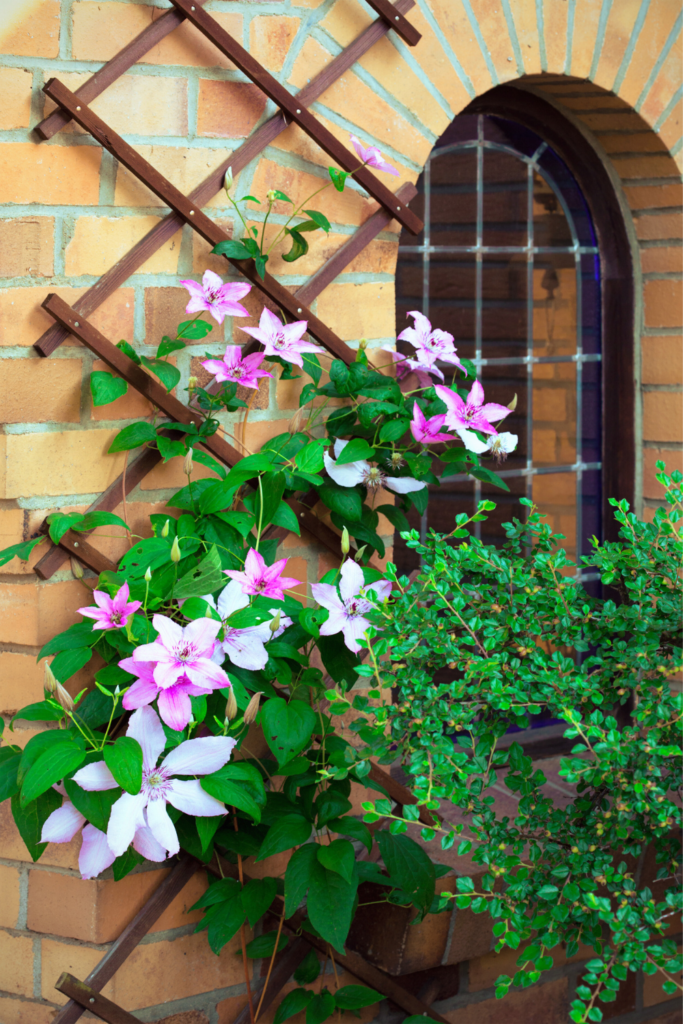
Are clematis easy to grow?
Clematis are easy to grow. Make sure your plants get plenty of sun, water, fertilizer and good soil to keep them happy and so that you can enjoy their gorgeous blooms!
How to Grow Clematis
Whether you’re a first-time gardener or an experienced grower, clematis can reward you with years of blooms. Each variety brings something unique, so experiment, observe, and enjoy the process. With the right care and patience, your clematis vines will become the heart of your garden’s story.
Growing clematis is one of the most rewarding joys in gardening. With a little attention and patience, you’ll enjoy vines covered in enchanting blooms that climb, twist, and weave their magic across your garden.
So go ahead, plant a clematis or two this season and watch your garden transform into a floral dreamscape.

